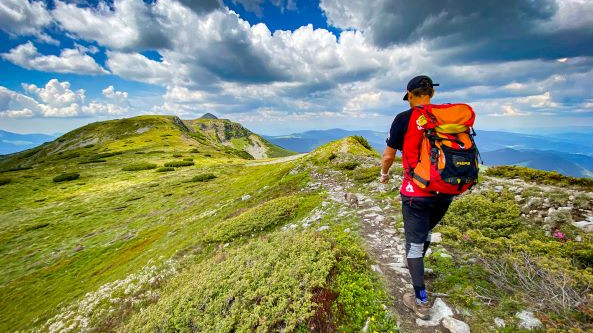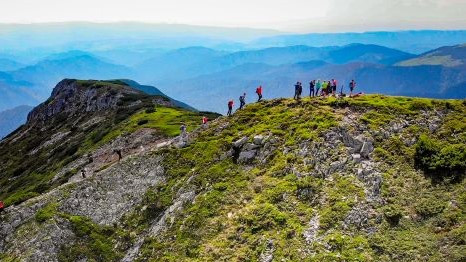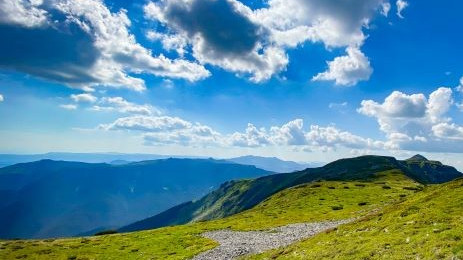What and how to pack before a hike
Whether you are a mountain enthusiast or just flirting with the idea of hiking, it's good to know how to prepare before heading out into nature. Here are a few things to consider.
General information
Before thinking about what and how to pack, we should be clear about what time of year we plan to go hiking, how many days it will take, what we will eat and, if it's going to last more than one day, where are we going to sleep. This will help us understand what kind of backpack to choose. For example, for a 1-day trip, a backpack with a capacity between 15-35 liters (in summer) is recommended, while the backpack for a 2–3-day trip should be of 40-60 liters. If the trip exceeds 3 days, we will need a larger backpack, of 60-90 liters, especially if we plan to sleep in a tent.
What kind of backpack to pick?
A comfortable backpack should be lightweight, well-padded and well divided. It should have an anatomical shape and a suitable length, adjustable shoulder, waist and chest straps that allow it to be positioned taking into account the wearer's center of gravity and height. It may also have a spacer to prevent perspiration. It helps to test the backpack before embarking on a longer journey, especially if it is new. It is not advised to use a backpack that has just been purchased.
From this point on we will be referring to a 1-day hike, during the summer, accessible to everyone. A hike that does not involve a heavy or large backpack. To make sure everything runs safely and that we enjoy our trip to the fullest, we'll check the weather and other details of the route. No matter how independent and skilled we think we are, at least one person should be aware of the length of the route and the itinerary we are planning to take, in order to avoid any unpleasant events. It's also good to know what the level differences are, whether or not there are water sources, possible dangers, so that we can then make a list of everything we need. A list drawn up in advance will allow us to remember if we have forgotten anything, so that we will be able to complete it before going shopping. Otherwise, we run the risk of finding ourselves missing essential things and we certainly want to avoid that.
What are we going to wear?
We should be able to rely on our footwear. Thus, the hiking boots should be chosen wisely. They should be comfortable, lightweight, waterproof, offer a trustworthy traction and good breathability. If the terrain we are venturing onto is not too demanding and does not require good stability, we can also use low footwear, but suitable for hiking. It is important to test the shoes towards the end of the day, in the evening when our feet are already tired and possibly swollen. We will consider seamless thicker socks, made of comfortable materials that breathe well and do not retain moisture. We should never go hiking wearing new, unworn shoes, the risk of injuries or bruises being high. It is advisable to have a pair of spare socks.
As for clothing... Hiking pants should be long, made of suitable, lightweight materials that allow ventilation, possibly waterproof. If it's very warm, long trousers that can easily be converted into shorts and vice versa can be practical. T-shirts, both the one we wear when starting our trip and the spare ones, should be made of synthetic materials, which quickly wick away sweat, dry fast, are comfortable and light. Cotton is not recommended. Even during the summer, we should take into account that the weather is often unpredictable and the mornings and evenings are cooler, so we should also have a warmer coat with us, such as a fleece top and/or a thin down jacket, as the case. Having a raincoat or waterproof jacket is important, even if no precipitation is forecast. They should also cover the backpack, if it is not already waterproof. A cap or a hat to protect us from the sun, some thin gloves, possibly a hiking bandanna, will complete the list.
What should we bring with us?
Now that we are all dressed, we can move on to the rest of the necessary things, such as those for good orientation: a printed map of the area, a compass and a phone with a GPS application. Or for those related to safety: a mini medical and first aid kit, an external battery, survival foil and a fire starter. Given the presence of bears in many areas, a bear whistle and bear spray could be useful.
Food and water can't be missing, of course. That is why we have to make sure that besides the ingredients for a heartier meal we will have some snacks, some sweets and enough water/tea, for the round trip. If we eat well before we leave, we won't be quickly overcome by hunger. We can bring sandwiches, fruits, fresh or dried (bananas, raisins or figs), dark chocolate, protein bars. We will choose foods that are high in protein and carbohydrates, non-perishable, easy to carry and consume. Hydration is essential when hiking so we will avoid salty or very sweet foods. It is good to keep ourselves properly hydrated, not only on the day of the hike, but also on the previous one. The amount of water required can vary between 1.5-4l depending on the duration of the hike, the existence or lack of water sources, our need for hydration, etc.
What else should we have on us?
Personal items and accessories are also important. We will take with us our ID, some money, sunscreen, lip balm, tissues and/or toilet paper, zip-lock bags, a garbage bag, a penknife, sunglasses and maybe trekking poles. It is extremely important to have a head torch with us, even if we don't plan to stay out at night on the trail, our tour could become longer than we expected, in which case it will be of great help.
How do we pack everything?
Good... We know now what we are going to take with us, but that's not enough. For a successful trip, the way we pack everything so that it fits in the backpack and is as close at hand as possible is also very important. We can start by putting all the stuff in one place, so that we can make sure we didn't miss anything on the list. We can then move on to sorting things out. We should think about what we will use first and which things we will need most often (food and water, map, phone). They should be placed in areas that are quickly and easily accessible, on the surface and on the sides of the backpack. Which things are heavier and which are lighter? Which are more rigid? For greater comfort heavier objects should be placed as close as possible to the back without affecting your center of gravity. We can ensure that we have a balanced weight distribution by placing lighter items around the heavier items in the middle. Empty spaces prevent us from effectively centering the backpack, so they are to be avoided. We have to make sure that all outer and inner pockets are used as efficiently as possible, and when we are on the trail, we will do our best to keep the backpack balanced. We will alternately consume the food and water placed on the sides, so that we don't have one heavier side than the other.
Ready to get going?
The final step, once everything is packed, is to take the backpack ready for hiking on the back, to make sure that everything is placed as it should be, that it is comfortable and that we can bear its weight. If necessary, the last adjustments can be made. Now that we know what and how to pack for a one-day summer hike, all we have to do is choose the destination and the route on which to venture.
We hope that the above information will help you have a rewarding and joyful tour on the wonderful routes in Mureş County, having a well-prepared backpack, with everything at hand.


